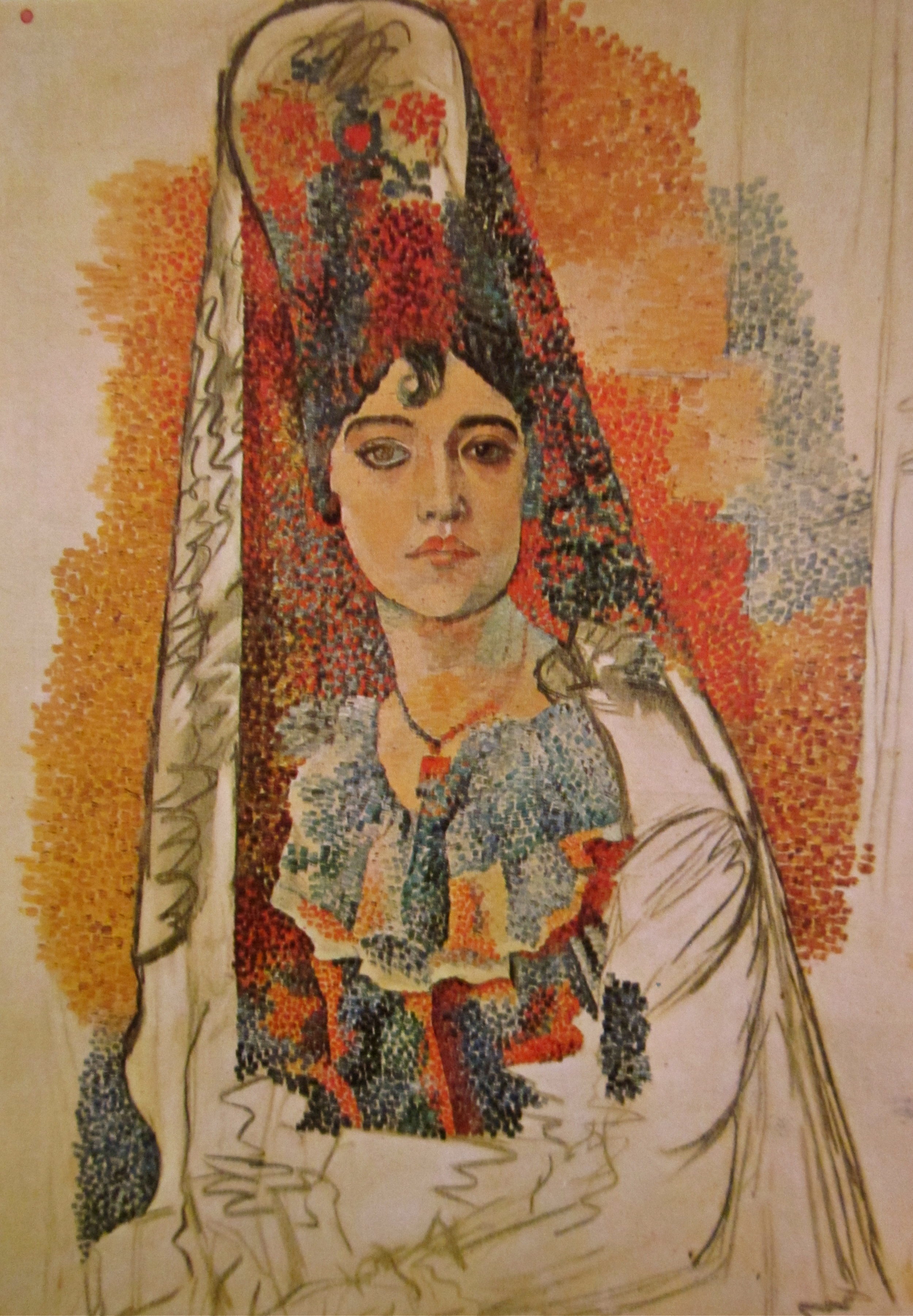A version of the painting The Scream sold a few years ago for almost $120 million, making it the most expensive artwork ever sold at auction at the time.
Read MoreArt Gallery Visitor Tip: Watch People Get Lost In The Art
Sometimes watching fellow visitors to a museum or gallery observe and react to the art is as much of an experience as observing the art yourself.
There are those that walk slowly from work to work, one hand behind their back, one on their chin, never pausing for longer than a few seconds.
Others insist on standing right in the middle of the work for minutes at a time, blocking the view for everyone else.
Couples often chat and point, commenting on the "vivid use of color" or "visible brushstrokes."
Then there are the people that make security guards nervous because they insist on leaning in so close that it looks like they are actually touching the work from a distance (these observers are often wearing thick academic looking glasses or artfully tied silk scarves).
We can’t forget the art students that tilt their heads to the side as they shuffle back and forth, trying to see the work from all angles as they fill page after page of their big black sketch books.
The rarest observers and my favorite to watch are the ones that are truly moved by what they are looking at.
The ones that gasp and inadvertently cover their mouth with their hand when they realize that they are face to face with a beloved painting, sculpture, or drawing that they had only ever seen in photos. Their faces literally glow and you can see a range of emotions pass through them while tears gather in the corners of their eyes, and they barely breathe.
After a few minutes, a goofy smile will cross their face and then suddenly self-conscious, they will glance around the room making sure no one saw their reaction, before moving on to the next piece.
Related Posts
Joseph Beuys: One Of The Most Influential Artists of Post-War Germany
Born in Krefeld, Germany in 1921, Joseph Beuys is considered to be one of the most influential artists and teachers of post-war Germany.
At the end of World War II, during which he was an aircraft radio operator and combat pilot, he began his journey as an artist by enrolling in the Dusseldorf Academy of Art. It was there that he discovered his mediums of choice — sculpture, installation, and performance art — which he referred to as "actions".
His belief was that "every person is an artist", and an individual’s creative activity — no matter how small — helps a society to grow and thrive in ways that are beneficial to all.
Filzanzug (Felt Suit), 1970 Joseph Beuys
Beuys is known in the art world for is his work with "multiples" or pieces that are easily created multiple times and are considered to be provocative due to the materials used or message they convey.
Creating works that could be easily duplicated was his way of reacting against what he deemed to be the precious and unique aspects of traditional art. These multiples were usually small 3D objects that were inexpensive to make.
His piece titled Filzanzug (Felt Suit), pictured above is an example of one of these multiples. It is said to have been inspired by a story that Beuys told of an event that happened to him during World War II (the truth of this story has never been confirmed). According to the artist, he was shot down from his plane during the war and when he was rescued, was wrapped first in fat and then in felt to bring back his body warmth.
This work, being made of felt, is considered to represent insulation or protection from what is going on in the world around us.
During the 1960s and '70s, a time of increased political awareness, Beuys was involved in political activism which he considered to be an extension of his activities as an artist. During an action titled Isolation Unit (thought to be a protest against the Vietnam War), he wore his Filzanzug (Felt Suit) for the entirety of the performance.
You can view this work at the Hamburger Bahnhof Museum of Contemporary Art in Berlin.
During his career, Beuys created over 600 multiples hoping that they would encourage creative thinking and work to democratize art.
He died on January 23, 1986.
Related Posts
Armless Propaganda: The Story of the Venus de Milo
The Venus de Milo is one of the most famous statues in the world, but like most famous art, one has to wonder what makes this piece more important than any of the other statues collecting dust in the galleries and storerooms of museums.
Well, first off, you can’t argue with the fact that she is beautiful.
Artists and critics have long praised the work as being the epitome of graceful female beauty, so much so that her image used to be on the seal of the American Society of Plastic Surgeons.
On the other hand, though, there are many beautiful statues — and many that still have arms.
Venus de Milo (Aphrodite of Melos), circa 150 BCE
Did she ever have arms?
No, Venus was not created without her upper limbs. She did originally have arms but was found with them already broken off. The buzz created by scholars over the mystery of the placement of her arms and what she may have once held has aided in her popularity. Only adding to the mystery is the fact that fragments found with the statue when it was dug up on the Island of Melos in 1820 have been lost.
The fragments, if reconstructed, would have been from the right arm of the statue and would have shown her holding an apple. Because the fragments were made of stone that was rougher than the rest of the statue, it was concluded that they were from an earlier restoration and so were set aside without being documented properly. They have now disappeared.
Scholars have recently speculated that the fragments were the originals and were carved differently because they would have been above the viewer's line of sight and so did not require a smooth surface (a common sculpting practice at the time of her creation). Without the fragments themselves, however, this can not be proven.
Who sculpted her?
Adding to her beauty, and the mystery behind her arms, is the fact that is is still not known who actually created the statue and for what purpose. Though it has been speculated that the artist may have been Alexandros of Antioch and she once sat in a high niche in the wall of an ancient city, none of this has been confirmed.
Though all of these facts are interesting, they do not add up to the kind of information that would attract the attention of the rest of the world.
Why is this Venus SO popular?
The main reason that this marble Venus is so recognizable is because of good ‘ol fashioned propaganda.
In 1815, France was forced to return the Medici Venus, which had been stolen by Napoleon Bonaparte, back to the Italians. It was (and still is) regarded as one of the finest classical sculptures in existence and to a country considered to be the art hub of Europe at the time, this was a HUGE blow to the ego.
When the Venus de Milo arrived at the Louvre so soon after the loss of the Medici Venus, French Officials immediately began promoting it as a greater treasure than what they had lost and voila, we now revere and recognize her as one of the most stunning and mysterious statues of the Hellenistic period.
Related Post
My Favourite Parisian Art Gallery: Exploring The Musee De L'Orangerie in Paris
Tips For Visiting The Louvre: How To Avoid The Crowds And Make The Most of Your Visit
The Palace of Versailles: The Home of The World's Most Notorious Playboy
What's So Special About The Mona Lisa? The Real Story Behind Da Vinci's Famous Painting
POP! A Brief Bio on the Iconic Andy Warhol
Beginning in the 1950s, artists influenced by Utopian American ads, Hollywood icons, pop music, comic books, and science fiction, started creating images that anyone walking down the street could recognize and declaring it art.
The public loved it, and with that, Pop Art was born!
Marilyn Monroe, circa 1962 Andy Warhol
The artist only began to paint Monroe after her death and — staying true to the Pop Art philosophy — was only interested in portraying Marilyn THE STAR, not Marilyn the person.
Though he wasn’t the founder of this movement, the work of Andy Warhol (1928-1987) is indisputably the most widely recognized art from this period. Warhol officially began his foray into the art world in 1960 when he made the choice to leave a career as a commercial illustrator and devote all his energy to art.
Though he started off painting, he made a quick switch and settled into the assembly line technique of silk-screening photo images on canvas. This technique allowed him to mass produce art, making it more available to purchase, and making him more money.
Mao Zedong (detail behind portrait), circa 1972 Andy Warhol
His portraits of Mao Zedong were a glamorization of the infamous communist ruler’s official portrait. A portrait that was used on billboards, brochures and books giving it the same iconic and pop presence in China as a Campbell Soup ad had in America at the time. It is speculated that Warhol chose to paint Mao because — according to LIFE Magazine — in 1972 he was declared the most famous person in the world.
These portraits are a departure from his other famous works because they are hand painted making each one unique compared to his other highly repetitive works (see Marilyn Monroe above).
Related Posts
When Modern Art Is Packing Tape In The Shape of A Streetlight
There’s a quote that comes to mind when looking at this work by Igor Eskinja, an artist from Croatia: "Modern Art = I could do that + Yeah, but you didn't."
Modernism, as an art movement, originated in the early 20th century in tandem with momentous changes in politics, economics, and science. The developments in art and culture were a way of exploring new possibilities of expression, especially abstraction, in a rapidly changing world.
This work, titled Liberare Le Menti Occupare Gli Spazi is made from cheap packing tape and is applied directly to the wall of the gallery. Echoing the fleeting, fast-moving quality of the modern world, Eskinja creates his art using ephemeral materials applied directly to gallery surfaces.
This work is destroyed after each exhibit and the artist himself often doesn’t even create the art but sends measurements and instructions for the curators to do the installation themselves.
I often find myself shaking my head when walking into a gallery with a show like this and asking myself who it was that decided packing tape, tape gun still attached, on the wall was art.
I could do that… a small child could do that!
But I guess what it comes down to is that fact that I didn’t do it, Igor Eskinja did, and somebody, somewhere thought that it mattered.
Related Posts
Michelangelo's Slaves: The Story Behind These Unfinished Sculptures
In 1505, Michelangelo was commissioned by Pope Julius II to design his huge, free-standing tomb. The artist went straight to work, traveling to the marble quarries of Carrara — in central Italy — to hand select the pieces that he would use to create statues for the tomb.
Choosing the stone for his sculptures was very important to the artist because he envisioned the statue as already existing within the marble.
He saw it as his job to set the statue free.
In 1506, work on the tomb was put on hold when Julius insisted that Michelangelo work on painting the Sistine Chapel instead, and started diverting funds, meant for the tomb, to building St Peter’s.
At the time of the Pope’s death in 1513, the tomb was still unfinished and was never completed to the original specifications
There were over 40 statues planned for the original tomb, and 16 of them were meant to be slaves. The meaning behind the slaves is unknown, but scholars speculate that they may have represented captured enemies, captured territories, or the liberal arts.
Though Michelangelo continued to work on them over the years, out of the planned 16 statues, only 2 were almost completed, while 4 exist in various stages of completion.
The two completed slaves have a home in the Louvre in Paris, while the unfinished keep the David — also by Michelangelo — company in the Galleria dell’ Academia in Florence. What makes these unfinished pieces so interesting is that they give us a rare look at how the artist worked. They are essentially 3-D sketches, where all mistakes and the artist’s process are exposed.
You can see what the artist meant when he said it was his job to ‘set the sculptures free’, as the forms seem to be trying to pull themselves out of the stone with their torso’s straining and muscles bulging. Despite a lack of finished detail, the works command a sense of mass and movement.
The time that Michelangelo lived in was ruled by the Catholic Church, which did not believe in regular autopsies or studying corpses for science. Therefore, there was very little known about human anatomy at the time (autopsies were not widely performed until the late 1600s).
It has been surmised that artists, like Michelangelo, used to sneak into morgues and look at the bodies, (sometimes even performing their own autopsies), in order to get a better understanding of how the muscular system looked under the surface.
Click here to see photos of the unfinished slaves.


























